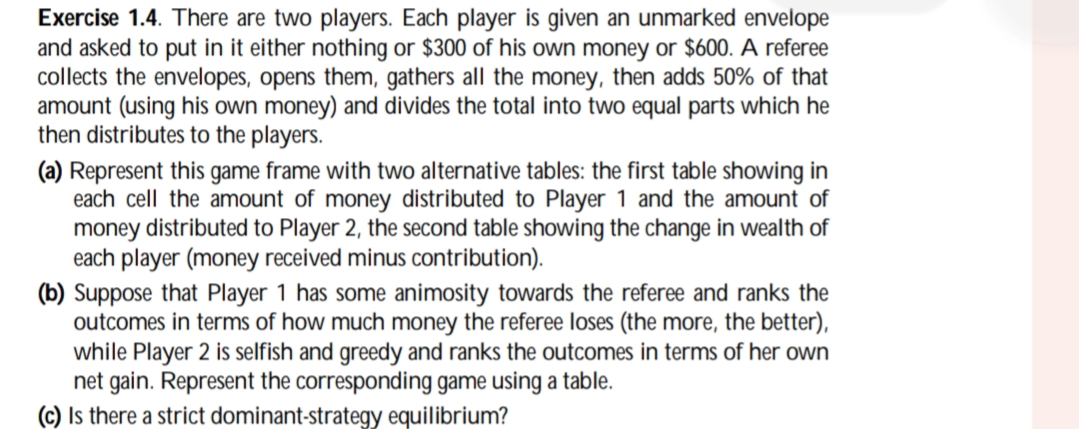Exercise 1.4. There are two players. Each player is given an unmarked envelope and asked to put in it either nothing or $300 of his own money or $600. A referee collects the envelopes, opens them, gathers all the money, then adds 50% of that amount (using his own money) and divides the total into two equal parts which he then distributes to the players. (a) Represent this game frame with two alternative tables: the first table showing in each cell the amount of money distributed to Player 1 and the amount of money distributed to Player 2, the second table showing the change in wealth of each player (money received minus contribution). (b) Suppose that Player 1 has some animosity towards the referee and ranks the outcomes in terms of how much money the referee loses (the more, the better), while Player 2 is selfish and greedy and ranks the outcomes in terms of her own net gain. Represent the corresponding game using a table. (c) Is there a strict dominant-strategy equilibrium?
Exercise 1.4. There are two players. Each player is given an unmarked envelope and asked to put in it either nothing or $300 of his own money or $600. A referee collects the envelopes, opens them, gathers all the money, then adds 50% of that amount (using his own money) and divides the total into two equal parts which he then distributes to the players. (a) Represent this game frame with two alternative tables: the first table showing in each cell the amount of money distributed to Player 1 and the amount of money distributed to Player 2, the second table showing the change in wealth of each player (money received minus contribution). (b) Suppose that Player 1 has some animosity towards the referee and ranks the outcomes in terms of how much money the referee loses (the more, the better), while Player 2 is selfish and greedy and ranks the outcomes in terms of her own net gain. Represent the corresponding game using a table. (c) Is there a strict dominant-strategy equilibrium?
Chapter2: Mathematics For Microeconomics
Section: Chapter Questions
Problem 2.15P
Question

Transcribed Image Text:Exercise 1.4. There are two players. Each player is given an unmarked envelope
and asked to put in it either nothing or $300 of his own money or $600. A referee
collects the envelopes, opens them, gathers all the money, then adds 50% of that
amount (using his own money) and divides the total into two equal parts which he
then distributes to the players.
(a) Represent this game frame with two alternative tables: the first table showing in
each cell the amount of money distributed to Player 1 and the amount of
money distributed to Player 2, the second table showing the change in wealth of
each player (money received minus contribution).
(b) Suppose that Player 1 has some animosity towards the referee and ranks the
outcomes in terms of how much money the referee loses (the more, the better),
while Player 2 is selfish and greedy and ranks the outcomes in terms of her own
net gain. Represent the corresponding game using a table.
(c) Is there a strict dominant-strategy equilibrium?
Expert Solution
This question has been solved!
Explore an expertly crafted, step-by-step solution for a thorough understanding of key concepts.
Step by step
Solved in 2 steps with 2 images

Recommended textbooks for you

